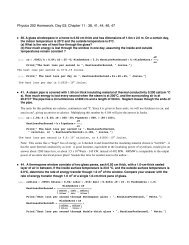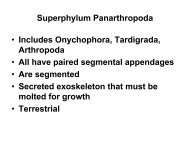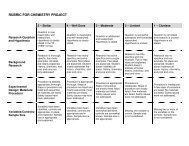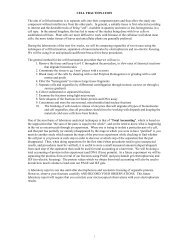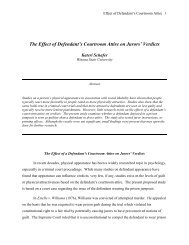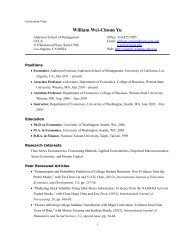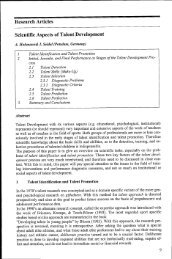Experiment 30 Preparation and Study of a Cobalt(li) Oxygen Adduct ...
Experiment 30 Preparation and Study of a Cobalt(li) Oxygen Adduct ...
Experiment 30 Preparation and Study of a Cobalt(li) Oxygen Adduct ...
You also want an ePaper? Increase the reach of your titles
YUMPU automatically turns print PDFs into web optimized ePapers that Google loves.
Szafran, Z.; Pike, R.; Singh, M., Microscale Inorganic Chemistry, John Wiley & Sons: New York, 1991, p. <strong>Experiment</strong> 257ff. <strong>30</strong> 253 257<br />
salenHz<br />
The salen chelating <strong>li</strong>g<strong>and</strong> has two atoms (0, N) as the donor sites <strong>and</strong> belongs<br />
to a special class <strong>of</strong> <strong>li</strong>g<strong>and</strong>s known as Schiffs bases.<br />
Co(salen) exists in two forms: One is the active species that absorbs oxygen,<br />
<strong>and</strong> the other is the inactive variety that does not react with oxygen, both <strong>of</strong><br />
which are dimeric. A solution <strong>of</strong> Co(salen) in a donor solvent (e.g., DMSO <strong>and</strong><br />
DMF) readily absorbs oxygen, forming an adduct with a peroxo-bridged oxygen<br />
<strong>li</strong>g<strong>and</strong>.<br />
Peroxo J<br />
bridge 1<br />
In these diamagnetic compounds, the cobalt is present in three oxidation states.<br />
In this experiment, the organic <strong>li</strong>g<strong>and</strong> salenHz is prepared, <strong>and</strong> subsequently<br />
reacted with hydrated cobalt acetate to prepare Co(salen). The oxygen up-take<br />
capacity <strong>of</strong> the compound is also investigated.<br />
Prior Reading <strong>and</strong> Techniques<br />
Section 5.C.2: Purging with an Inert Gas<br />
Section 5.0.3: Isolation <strong>of</strong> Crystal<strong>li</strong>ne Products (Suction<br />
FiltrationI
254 Szafran, Chapter Z.; Pike, 8 R.; I Chemistry Singh, M., Microscale <strong>of</strong> the Transition Inorganic Chemistry, John Wiley & Sons: New York, 1991, p. 257ff. 257<br />
EXPERIMENTAL SECTION<br />
Related <strong>Experiment</strong>s<br />
<strong>Cobalt</strong> Complexes: <strong>Experiment</strong>s 7B, 17,26,27,35, <strong>and</strong> 47B<br />
Part A: <strong>Preparation</strong> <strong>of</strong> N,N-Bls(sa"cylaldehyde Jethylened<strong>li</strong>mlne, salenHz<br />
CHEMICAL DATA Compound<br />
Safety Recommendations<br />
Sa<strong>li</strong>cylaldehyde (CAS No. 90-02-8): This compound is harmful if swallowed,<br />
inhaled, or absorbed through the skin. ORL-RA T LD50: 520 mglkg. It<br />
has been shown to have effects on ferti<strong>li</strong>ty.<br />
Ethylenediamine (CAS No. 107-15-3): This compound is harmful if swallowed,<br />
inhaled, or absorbed through the skin. ORL-RA T LD50: 500 mg/kg. It<br />
has an irritating ammonia odor (vapor pressure is 10 mm at 20 ec), so it should<br />
only be used in the HOOD.<br />
Sa<strong>li</strong>cylaldehyde 122.12 500 mg 4.09 1 197 1.146<br />
Ethylenediamine 60.10 120 mg 2.00 8.5 118 0.899<br />
Required Equipment<br />
Magnetic stirring hot plate, s<strong>and</strong> bath, 1O-mL Erlenmeyer flask, magnetic stirring<br />
bar, ice-water bath, Hirsch funnel, clay tile.<br />
Time Required for <strong>Experiment</strong>: 0.5 h.<br />
EXPERIMENTAL PROCEDURE Place 5.0 mL <strong>of</strong> 95% ethanol in a 1O-mL Erlenmeyer flask equipped with a<br />
magnetic stirring bar. Put the flask in a s<strong>and</strong> bath, set atop a magnetic stirring<br />
hot plate, <strong>and</strong> heat the ethanol to boi<strong>li</strong>ng. Immediately, with stirring, add<br />
450 j.LL (4.09 mmol) <strong>of</strong> sa<strong>li</strong>cylaldehyde. To the boi<strong>li</strong>ng solution, add 140 J.LL<br />
(2.0 mmol) <strong>of</strong> ethylenediamine.<br />
Isolation <strong>of</strong> Product<br />
Stir the solution for 3-4 minutes, <strong>and</strong> cool the solution in an ice-water bath.<br />
Collect the yellow crystals by suction filtration using a Hirsch funnel. Wash the<br />
product with 2 drops <strong>of</strong> ethanol <strong>and</strong> dry on a clay tile. Determine the melting<br />
point <strong>and</strong> calculate a percentage yield.<br />
Part B: <strong>Preparation</strong> <strong>of</strong> Co(salen)<br />
Additional Safety Recommendations<br />
<strong>Cobalt</strong>(lI) acetate tetrahydrate (CAS No. 6147-53-1): This compound<br />
is harmful if inhaled or swallowed. ORL-RAT LD50: 708 mglkg.<br />
CHEMICAL DATA Compound FW Amount _0101 mp (OC)<br />
salenH2 268.32 2<strong>30</strong> mg 0.56<br />
<strong>Cobalt</strong>(1I) acetate<br />
tetrahydrate 249.09 200 mg 0.80 1. 705
256 Chapter 8 I Chemistry <strong>of</strong> the Transition<br />
Side-arm<br />
test tube<br />
Szafran, Z.; Pike, R.; Singh, M., Microscale Inorganic Chemistry, John Wiley & Sons: New York, 1991, p. 257ff. 257<br />
EXPERIMENTAL PROCEDURE<br />
Measuring -----{:-:":-::-3<br />
buret<br />
Tygon tube<br />
Movable<br />
tube<br />
Tygon tube<br />
Figure 8.11. Movable tube apparatus.<br />
Part C: Determination <strong>of</strong> <strong>Oxygen</strong> Absorption by Colsalenl<br />
Additional Safety Recommendations<br />
Dimethy. salfoxide (CAS No. 67-68-S): This compound is harmful if<br />
swallowed, inhaled, or absorbed through the skin. ORL-RAT LDSO: 14,SOO mgl<br />
kg.<br />
Required Equipment<br />
Graduated cy<strong>li</strong>nder, 2 x 18-cm side arm test tube with rubber stopper,<br />
1 x 7.S-cm test tube, forceps, two lO-mL burets, Tygon tubing.<br />
Time Required for <strong>Experiment</strong>: 1.5 h.<br />
Place SO-100 mg <strong>of</strong> Co(salen) (from Part <strong>30</strong>.B) at the bottom <strong>of</strong> a<br />
2 x 18-cm side arm test tube. Using a graduated cy<strong>li</strong>nder, transfer S mL <strong>of</strong><br />
DMSO to a 2S-mL beaker, <strong>and</strong> saturate the complexing solvent by bubb<strong>li</strong>ng<br />
O2 gas through it. Fill the 1 x 7.S-cm test tube with oxygen-saturated DMSO<br />
to a level 2 cm from the rim. Using a pair <strong>of</strong> forceps, carefully lower the smaller<br />
test tube into the side arm test tube. Make sure that no DMSO spills out from<br />
the test tube. In case DMSO spills out, dry the side arm test tube, <strong>and</strong> try again.<br />
Using Tygon tubing, connect the bottom <strong>of</strong> a 10-mL buret (henceforth called<br />
a measuring buret) to the bottom <strong>of</strong> a second lO-mL buret (henceforth called<br />
a movable tube), which will act as a water reservoir. Secure the arrangement<br />
with damps to a strong ring st<strong>and</strong>. Fill the movable tube with water, <strong>and</strong> allow<br />
water to drain so that the Tygon tubing is filled with water, <strong>and</strong> water begins<br />
to enter the measuring buret. Attach the top <strong>of</strong> the measuring buret to the side<br />
arm <strong>of</strong> the larger test tube. Adjust the height <strong>of</strong> the movable tube so that the<br />
water level remains near the bottom <strong>of</strong> the measuring buret. This apparatus is<br />
shown in Figure 8.11.<br />
Rush the side arm test tube through its mouth for a few minutes with oxygen<br />
gas. Tightly seal the mouth <strong>of</strong> the side arm test tube with a rubber stopper.<br />
Adjust the height <strong>of</strong> the movable tube so that the water in the measuring buret<br />
<strong>and</strong> in the water reservoir tube are at the same levels. Note the initial water<br />
level from the measuring buret. Carefully invert the side arm tube in such a way<br />
that DMSO pours out from the smaller test tube, allOwing it to react with the<br />
Co(salen) at the bottom <strong>of</strong> the side arm test tube. Make certain that DMSO<br />
does not enter into the Tygon tubingl Gently shake the side arm test<br />
tube so as to dissolve the Co(salen) in the DMSO. As oxygen is absorbed by<br />
this solution, the water level in the measuring buret will start rising. Continue<br />
shaking the side arm tube until the water level no longer changes. The process<br />
should not require more than 20 min. Readjust the height <strong>of</strong> the movable tube<br />
so that the water levels in both the tubes are the same. Note the final water<br />
level in the measuring buret.<br />
Calculations<br />
Calculate the decrease in the volume <strong>of</strong> water caused by the absorption <strong>of</strong><br />
oxygen gas by the Co(salen) in DMSO. This is equivalent to the volume <strong>of</strong><br />
oxygen uptake by Co(salen). Note the atmospheric pressure from a barometer.<br />
Record the room temperature. Using the vapor pressure <strong>of</strong> water at that temperature,<br />
calculate the number <strong>of</strong> moles <strong>of</strong> O2 gas absorbed using the ideal gas<br />
law equation.<br />
n = (P - f)VIRT<br />
where f is the vapor pressure <strong>of</strong> water at room temperature.
Szafran, Z.; Pike, R.; Singh, M., Microscale Inorganic Chemistry, John Wiley & Sons: New York, 1991, experiment p. 257ff. 31 257 257<br />
Part D: Reaction <strong>of</strong> the <strong>Oxygen</strong> <strong>Adduct</strong> with Chlor<strong>of</strong>orm<br />
Time Required for <strong>Experiment</strong>: 0.25 h.<br />
EXPERIMENTAL PROCEDURE Transfer the dark brown so<strong>li</strong>d from Part <strong>30</strong>.C into a centrifuge tube. Centrifuge<br />
the mixture <strong>and</strong> remove the supernatant <strong>li</strong>quid. Layer the residue with a few<br />
drops <strong>of</strong> chlor<strong>of</strong>orm <strong>and</strong> observe what happens. An evolution <strong>of</strong> oxygen gas<br />
should be seen as the complex deoxygenates.<br />
QUESTIONS 1. In terms <strong>of</strong> the chemistry <strong>of</strong> Fe(II) describe the triggering mechanism in<br />
hemoglobin.<br />
2. Why is CO so deadly to human respiration? (Hint: Consider the bonding<br />
to the iron in hemoglobin.)<br />
3. There is a reasonable correlation between the 0--0 bond length in metal<br />
(dioxygen) complexes <strong>and</strong> the reversibi<strong>li</strong>ty <strong>of</strong> the addition reaction. Discuss.<br />
4. <strong>Cobalt</strong> is also found in other molecules <strong>of</strong> biological interest. Give an example<br />
<strong>and</strong> discuss its biological properties.<br />
5. Certain porphyrin complexes <strong>of</strong> cobalt(II) can be substituted into globin to<br />
form cobalt analogs to hemoglobin. Discuss the similarities <strong>and</strong> differences<br />
between these complexes. A useful initial <strong>li</strong>terature reference is H<strong>of</strong>fman, B.<br />
M., Petering, D. H. Proc. Natl. Acad Sci. USA 1970.67,637.<br />
REFERENCES 1. Appleton, T. G. J. Chem. Educ. 1977.54,443.<br />
2. K1evan, J.; Peone, J.; Madan, S. K. J. Chem. Educ. 1973.50, 670.<br />
3. Basolo, F.; H<strong>of</strong>fman, B. M.; Ibers, J. A. Acct. Chem. Res. 1975.8,384.<br />
;!




